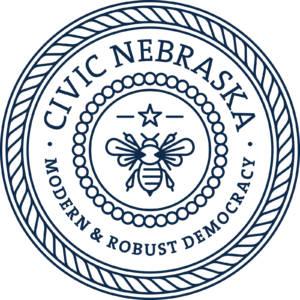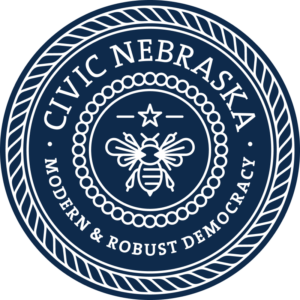109th Nebraska Legislature
First Session (2025)
BILL TRACKER
Bill introduction begins Jan. 8 and ends Jan. 22.
VOTING RIGHTS
Introduced 1.9.25 by Lippincott
OPPOSED
The way Nebraska awards its electoral votes is part of what sets our state apart, and part of what unites us. While most other states give all their electoral college votes to the candidate who wins the popular vote in the state, in Nebraska we can allocate our votes by congressional district. This is a Nebraska tradition because of our deeply nonpartisan heritage that promotes fair representation and boosts participation on Election Day.
Nebraska’s process means more Nebraskans get their voices genuinely heard and ensures that our relatively small state is uniquely represented in national politics, and gives every Nebraska voter a true sense of their participation being critical.
CIVIC EDUCATION
GOVERNANCE
HOW A BILL BECOMES A LAW IN NEBRASKA
1. Bill Introduction
When a Nebraska senator has an idea for a new law, they team up with a bill drafter to turn that idea into the official legal format for a bill. Nebraska is a bit unique—bills here can only cover one subject at a time.
Most senators introduce their bills during the first 10 days of the legislative session, which kicks off every January.
2. Committee
Next, the bill is assigned to one of 14 committees. Every bill gets a public hearing in committee. This is where citizens can share their opinions with lawmakers.
Once the hearing ends, the committee can vote to send the bill to the floor (with or without changes), shelve it indefinitely, or take no action at all.
3. General File
This is the first chance for the entire Legislature to debate and vote on bills. Senators can propose and discuss amendments, whether from committees or individual lawmakers. Many see this stage as the most critical step since it’s where most compromises occur. To move a bill forward or adopt any amendments, at least 25 senators must vote in favor.
4. Select File
Select File is the second stage for senators to debate and vote on bills. It’s another chance to propose amendments, make compromises, and take a closer look at the details. At this point, a bill can either move forward to the next stage or be shelved indefinitely. Once a bill passes Select File, it goes back to the Enrollment and Review (E & R) office for a final check, and then it’s reprinted for Final Reading.
5. Final Reading & Passage
Bills can’t be debated or amended, but can be sent back to Select File for a specific change. Voting on a bill can’t happen until at least five legislative days after it’s introduced and one day after it’s placed on Final Reading. Bills need a simple majority (25 votes) to move to the governor. Those with an emergency clause require two-thirds (33 votes).
A proposed constitutional amendment takes 30 votes to put it on the general election ballot and 40 votes to add it to a primary or special election ballot.
6. Governor's Desk
Once the Legislature passes a bill on Final Reading, it heads to the governor. The governor has five days (not counting Sundays) to decide what to do. If they sign the bill — or simply don’t act on it — it becomes law. The governor can also veto a bill or use a line-item veto to remove specific budget items. However, the Legislature can override a veto, but it takes 30 senators to make that happen.


